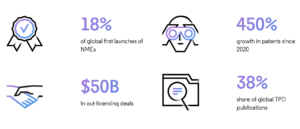
Analytical demand of CRISPR gene therapies
Gene Editing?CRISPR-Cas9 gene editing offers substantial improvements over previous gene editing technologies in terms of ease of use, speed, efficacy, and cost. Not surprisingly, CRISPR-Cas9 editing has taken biomedical science by storm. While the technology is relatively simple in handling at the level of basic research, the use of CRISPR genome editing in therapeutical applications poses a bunch of
analytical challenges.
The first CRISPR-Cas9 based therapeutics are now in Phase I/II clinical trials, such as the treatment of sickle cell disease developed by CRISPR Therapeutics and Vertex. Regulations and guidelines valid for cell and gene therapies also apply for CRISPR-mediated therapies (i.e. Chemistry, Manufacturing, and Control (CMC) Information for Human Gene Therapy Investigational New Drug Applications (INDs): Guidance to Industry) published by FDA.
The aim of these regulations is to define the correct characterisation of the drug substance / drug product (DS/DP) to ensure product quality and safety. In the case of CRISPR-Cas9-based therapeutics, the questions to address include but are not limited
to:
- (i) on-target editing frequencies,
- (ii) off-target editing frequencies,
- (iii) expression level of transgenes,
- (iv) quantification of putative translocation.
Besides the characterisation of the DS/DP, critical reagents and raw material used in the manufacturing must be quality-controlled. In the CRISPR setting, for example, identity testing of the synthesized single guide RNA sequences is required. Other tools used for the gene editing such as vectors and/or plasmids must also be tested.
Each analytical procedure (AP) will follow a life cycle starting with the development phase that might also include some exploratory analysis, such as the identification of putative off-target loci. The development phase is followed by the qualification and finally by the validation of the analytical procedure before entering the routine testing.
Validation of analytical procedure
The aim of the validation is to demonstrate that the AP is suitable for its intended use. It is critical that the validation complies with the relevant guidelines (i.e. ICH guideline: Validation of analytical procedures: Text and Methodology Q2(R1). The guidelines define different assay classes: for example (1) identity assays that allow unequivocal identification of a component(s), or (2) quantitative assays suited to describe the editing rates (on target edits/off-target edits but also translocations). Thus, depending on the specific task, the validation of an AP may significantly differ and require more or less effort
A close interaction with the sponsor is needed to understand the scope of the analytical procedure and to define its intended use jointly with the sponsor.
Challenges in the validation
Besides general characteristics, it is also important to already know the (product) specification for the analysis, which will help to find the best analysis strategy. A challenge in the validation of CRISPR-Cas therapies is that control material for the validation must be produced and qualified and no A reference standard (i.e. USP compendial standards) or commercially supplied reference standards are available.
Moreover, the same analytical procedure to be validated is also used to qualify the reference material – orthologous methods to establish the "accepted true value" are usually not available. This may be problematic for addressing the accuracy parameter as the "accepted true value" is already an estimate and can be a source of variation.
Microsynth expertise
Microsynth was involved in several programs for CRISPR-Cas9-related cell therapies and gained key expertise in the development and qualification/validation of different analytical procedures over the last years including routine testing of clinical test items. To request more information: info@microsynth.ch.
This article was originally published in Autumn Edition European Biotechnology Magazine 2021.


 White House
White House Clarivate
Clarivate H. Zell - wikipedia.org
H. Zell - wikipedia.org